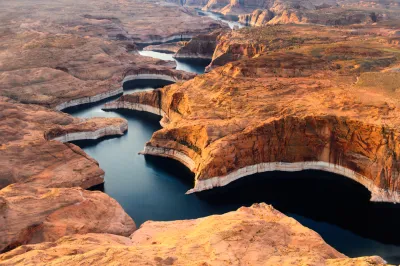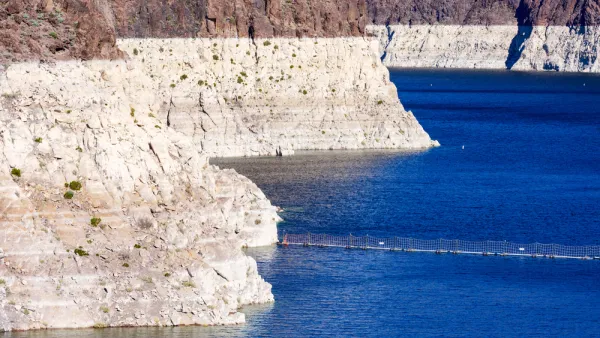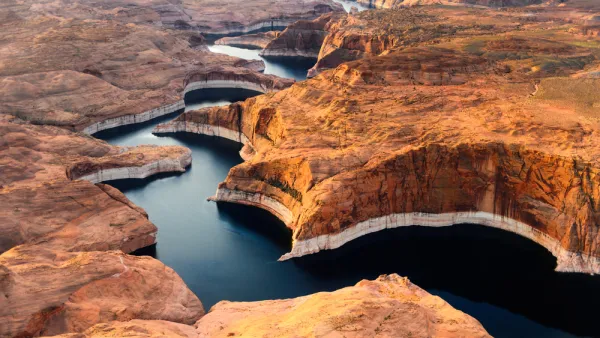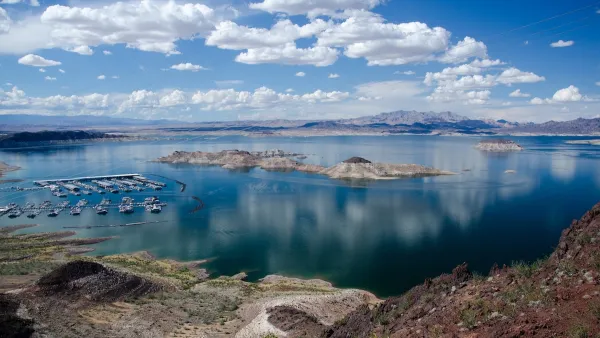In the throes of a historic megadrought, three Southwestern states will make deep reductions in their water usage to preserve diminishing resources.

After the federal government declared a historic water shortage for Lake Mead this summer, California, Arizona, and Nevada have agreed to reduce the amount of water they procure from the Colorado River in an effort to save one million acre-feet from leaving the reservoir in the next two years. As reported by Jaweed Kaleem and Ian James, "Water agencies in Southern California, Arizona and Nevada agreed to find water savings from various sources and split the $200-million cost with the federal government."
As water levels in Lake Mead and Lake Powell, the Colorado River's other major reservoir, continue to decline, experts say states may have to make even deeper cuts to adapt to a future with less water. "The new deal, called the 500+ Plan, nearly doubles the water reductions that the three states — which make up the lower basin of the river — negotiated in 2019 under what is called the drought contingency plan." The deal is a step toward correcting over-allocated water rights, but environmental groups say upriver states must also reduce their usage. Meanwhile, Utah is proposing a controversial new pipeline that would draw more water to that state.
Local tribes hold 20 percent of water rights and have contributed crucial efforts, yet have remained largely unrecognized in official negotiations. During this latest round of agreements, leaders from the Gila River Indian Community and the Colorado River Indian Tribes were present as signatories.
FULL STORY: California, Arizona and Nevada agree to take less water from ailing Colorado River

National Parks Layoffs Will Cause Communities to Lose Billions
Thousands of essential park workers were laid off this week, just before the busy spring break season.

Retro-silient?: America’s First “Eco-burb,” The Woodlands Turns 50
A master-planned community north of Houston offers lessons on green infrastructure and resilient design, but falls short of its founder’s lofty affordability and walkability goals.

Delivering for America Plan Will Downgrade Mail Service in at Least 49.5 Percent of Zip Codes
Republican and Democrat lawmakers criticize the plan for its disproportionate negative impact on rural communities.

Test News Post 1
This is a summary

Test News Headline 46
Test for the image on the front page.

Balancing Bombs and Butterflies: How the National Guard Protects a Rare Species
The National Guard at Fort Indiantown Gap uses GIS technology and land management strategies to balance military training with conservation efforts, ensuring the survival of the rare eastern regal fritillary butterfly.
Urban Design for Planners 1: Software Tools
This six-course series explores essential urban design concepts using open source software and equips planners with the tools they need to participate fully in the urban design process.
Planning for Universal Design
Learn the tools for implementing Universal Design in planning regulations.
EMC Planning Group, Inc.
Planetizen
Planetizen
Mpact (formerly Rail~Volution)
Great Falls Development Authority, Inc.
HUDs Office of Policy Development and Research
NYU Wagner Graduate School of Public Service





























